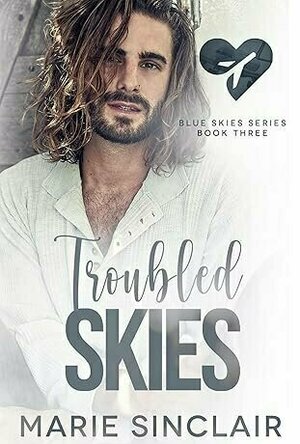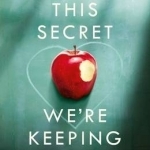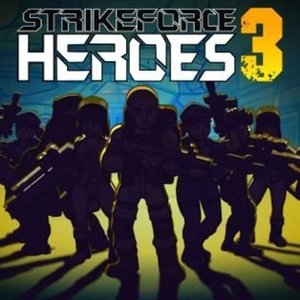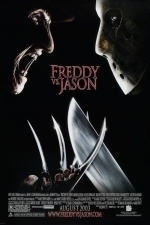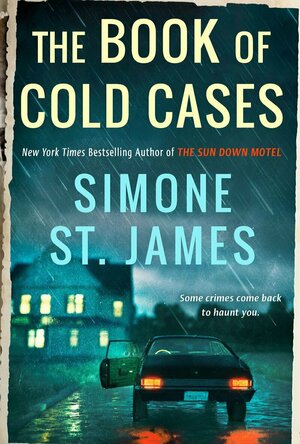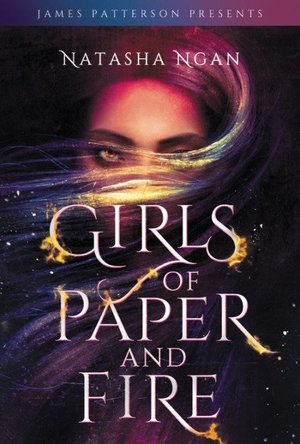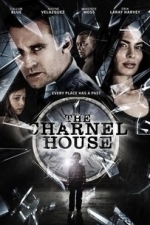Search
Search results
Merissa (13585 KP) rated Troubled Skies (Blue Skies #3) in Books
Sep 8, 2025
TROUBLED SKIES is the third and final book in the Blue Skies trilogy, but the first one I have read. Did I need to read the first two? No, but now I definitely want to.
You know how sometimes, you just want a nice, easy book to whisk you away to a different world from the one you currently live in? Well, that was me, and this book came up on my TBR list at just the right time.
It begins pretty angsty - Ricky is in an Air Traffic accident and ends up in hospital. Not only that, but he's also peeved about his friends finding love (it's reasonable, sort of, trust me!), AND gets kicked out of his home by a landlord that isn't worth the time on the page. So, he does what any reasonable person would do... he splurges his life savings on a ticket to Ibiza and uses his middle name, Adrian, instead of Ricky. Of course, that would work better if he didn't have to board a plane to get to Ibiza. No, scrap that - two planes! Luckily for him, Ren is on hand to help his nerves.
This book had me from the very beginning. No, I don't 100% know why Ricky was so peeved, but the explanations given in the book make perfect sense. The fact that he wanted to get away also makes sense. And Ren... ah, what can I say? I loved him from the very beginning. Okay, maybe not the VERY beginning, but as soon as he meets Adrian, definitely. I also loved how they both had their worries about how this would work in the future, but that didn't stop them from enjoying the time they had.
Ren is the more steadfast character out of the two, which was surprising considering his playboy prince persona. I loved how he did everything he could to ease Adrian's life (when Adrian would let him!) and show him different things. Honestly? If Adrian had asked for the sun, Ren would have been on the phone to someone to figure out how to make it happen. And while Ren was my favourite, I also understood how Adrian felt. Bless him, it was all a bit much after everything he'd been through.
A light-hearted, somewhat low-level angsty, and oh-so romantic story. Just what I need and absolutely 100% adored - of course I recommend it!
ps - Did Sheila survive? My mind won't let it go!!!
** Same worded review will appear elsewhere. **
* A copy of this book was provided to me with no requirements for a review. I voluntarily read this book; the comments here are my honest opinion. *
Merissa
Archaeolibrarian - I Dig Good Books!
Sep 8, 2025
You know how sometimes, you just want a nice, easy book to whisk you away to a different world from the one you currently live in? Well, that was me, and this book came up on my TBR list at just the right time.
It begins pretty angsty - Ricky is in an Air Traffic accident and ends up in hospital. Not only that, but he's also peeved about his friends finding love (it's reasonable, sort of, trust me!), AND gets kicked out of his home by a landlord that isn't worth the time on the page. So, he does what any reasonable person would do... he splurges his life savings on a ticket to Ibiza and uses his middle name, Adrian, instead of Ricky. Of course, that would work better if he didn't have to board a plane to get to Ibiza. No, scrap that - two planes! Luckily for him, Ren is on hand to help his nerves.
This book had me from the very beginning. No, I don't 100% know why Ricky was so peeved, but the explanations given in the book make perfect sense. The fact that he wanted to get away also makes sense. And Ren... ah, what can I say? I loved him from the very beginning. Okay, maybe not the VERY beginning, but as soon as he meets Adrian, definitely. I also loved how they both had their worries about how this would work in the future, but that didn't stop them from enjoying the time they had.
Ren is the more steadfast character out of the two, which was surprising considering his playboy prince persona. I loved how he did everything he could to ease Adrian's life (when Adrian would let him!) and show him different things. Honestly? If Adrian had asked for the sun, Ren would have been on the phone to someone to figure out how to make it happen. And while Ren was my favourite, I also understood how Adrian felt. Bless him, it was all a bit much after everything he'd been through.
A light-hearted, somewhat low-level angsty, and oh-so romantic story. Just what I need and absolutely 100% adored - of course I recommend it!
ps - Did Sheila survive? My mind won't let it go!!!
** Same worded review will appear elsewhere. **
* A copy of this book was provided to me with no requirements for a review. I voluntarily read this book; the comments here are my honest opinion. *
Merissa
Archaeolibrarian - I Dig Good Books!
Sep 8, 2025
Hazel (1853 KP) rated This Secret We're Keeping in Books
May 25, 2017
Well-Written
I received this book for free through Goodreads First Reads.
A pupil and a teacher. Is it ever right to break the rules? This is the dilemma which debut author Rebecca Done basis her novel on. This Secret We’re Keeping is set seventeen years after a maths teacher began an inappropriate relationship with a schoolgirl; but did he really deserve what happened to him, after all he loved her and she loved him?
Jess has never got over her love for the teacher she ran away with when she was fifteen. Although she has got her life together: living in Norfolk, freelance catering business, a rich boyfriend; she cannot help but think back to way Mr. Landley, Matthew, made her feel. Suddenly, after a chance encounter, Matthew is back in her life with a new name, Will, and a girlfriend and daughter. Delighted to see each other again, it is not long before they fall back into their illicit affair, however the potential consequences are almost as bad as the previous time.
This Secret We’re Keeping causes the reader to question strong personal beliefs, primarily whether a teacher-student relationship is as wrong as it sounds. If certain events in this novel were to be made public through the media, the majority would instantly hate Matthew, deem him a paedophile, and be satisfied with his punishment. However on reading the situation from his point of view, initial opinions begin to crumble. It appears he genuinely loved Jess, and she him; there were no abusive occurrences, and it was Jess that instigated the relationship in the first place. Did Matthew truly deserve to go to prison for something that would have been legal in a year’s time?
Matthew/Will’s narrative helps to show that it is virtually impossible to pinpoint a single moment that changes a life forever. At which point did he know that he had stepped over the line from right to wrong? In hindsight it is fairly obvious, but at the time the warning signs are not so clear.
Due to the challenging of preset judgments, This Secret We’re Keeping can often be difficult to read. Whilst on the one hand logic will be screaming, “This is wrong!” Done plays with her readers’ sentimentalities to consider the other side of the argument. As the novel progresses it becomes easier to fall in line with Jess and Matthew/Will’s viewpoints, however a brief interaction towards the end forces readers to temporarily reconsider their forgone conclusion. After all, how much can a first person narrative really be trusted?
Having read the blurb I admit I was a bit wary about reading this book. For one, it falls under the genre of Chick Lit, which I am not all that fond of, but secondly the book’s theme appeared rather controversial. On the whole, This Secret We’re Keeping was much better than I was anticipating, however I began to lose interest towards the end as nothing much had changed throughout the present day chapters, and it was already obvious how the past narrative would pan out. The ending is also frustratingly ambiguous, as we never find out whether either of the key characters gets a “happy ever after.”
If you are someone who enjoys Chick Lit, do not let the themes of the book put you off. This Secret We’re Keeping is essentially a romance story, one that is written remarkably well for a first time author. Rebecca Done will be a name to look out for in the world of contemporary literature.
A pupil and a teacher. Is it ever right to break the rules? This is the dilemma which debut author Rebecca Done basis her novel on. This Secret We’re Keeping is set seventeen years after a maths teacher began an inappropriate relationship with a schoolgirl; but did he really deserve what happened to him, after all he loved her and she loved him?
Jess has never got over her love for the teacher she ran away with when she was fifteen. Although she has got her life together: living in Norfolk, freelance catering business, a rich boyfriend; she cannot help but think back to way Mr. Landley, Matthew, made her feel. Suddenly, after a chance encounter, Matthew is back in her life with a new name, Will, and a girlfriend and daughter. Delighted to see each other again, it is not long before they fall back into their illicit affair, however the potential consequences are almost as bad as the previous time.
This Secret We’re Keeping causes the reader to question strong personal beliefs, primarily whether a teacher-student relationship is as wrong as it sounds. If certain events in this novel were to be made public through the media, the majority would instantly hate Matthew, deem him a paedophile, and be satisfied with his punishment. However on reading the situation from his point of view, initial opinions begin to crumble. It appears he genuinely loved Jess, and she him; there were no abusive occurrences, and it was Jess that instigated the relationship in the first place. Did Matthew truly deserve to go to prison for something that would have been legal in a year’s time?
Matthew/Will’s narrative helps to show that it is virtually impossible to pinpoint a single moment that changes a life forever. At which point did he know that he had stepped over the line from right to wrong? In hindsight it is fairly obvious, but at the time the warning signs are not so clear.
Due to the challenging of preset judgments, This Secret We’re Keeping can often be difficult to read. Whilst on the one hand logic will be screaming, “This is wrong!” Done plays with her readers’ sentimentalities to consider the other side of the argument. As the novel progresses it becomes easier to fall in line with Jess and Matthew/Will’s viewpoints, however a brief interaction towards the end forces readers to temporarily reconsider their forgone conclusion. After all, how much can a first person narrative really be trusted?
Having read the blurb I admit I was a bit wary about reading this book. For one, it falls under the genre of Chick Lit, which I am not all that fond of, but secondly the book’s theme appeared rather controversial. On the whole, This Secret We’re Keeping was much better than I was anticipating, however I began to lose interest towards the end as nothing much had changed throughout the present day chapters, and it was already obvious how the past narrative would pan out. The ending is also frustratingly ambiguous, as we never find out whether either of the key characters gets a “happy ever after.”
If you are someone who enjoys Chick Lit, do not let the themes of the book put you off. This Secret We’re Keeping is essentially a romance story, one that is written remarkably well for a first time author. Rebecca Done will be a name to look out for in the world of contemporary literature.
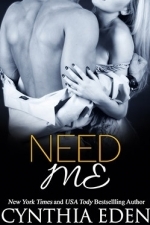
Need Me (Dark Obsession, #3)
Book
Innocent…or guilty? The cops think that Julianna Smith is a murderer. No one will listen when...
Gareth von Kallenbach (980 KP) rated Strike Force Heroes 3 in Video Games
Jun 19, 2019
The world of Free to Play Games has a fantastic new entry with the arrival of Strike Force Heroes 3. The game is harkens back to the classic side scrolling action games of the past but incorporates modern graphics, sound, and physics in a winning combination.
Players pick a squad character and then enter a mission armed with a variety of weapons such as an automatic rifle and a pistol. Players can switch between weapons as needed with a single key press and use the mouse to get a full 360 degree range of fire and vision as the leap between the various platforms to dispatch enemies, gain power ups, and avoid traps.
The campaign of the game offers 50 new missions and there are also new weapons and perks such as an aim bot that greatly help combat available for players compared to the previous game in the series.
The game also offers some solid music and sound effects, much better than one would come to expect in a free to play game and really helps ramp up the intensity of the game.
The high number of weapons and perks that become available to players as the game unfolds is really amazing as players have the freedom to find a loadout that best reflects their style of play rather than being forced to adapt to a rigid in game standard.
The game is played on a PC so that means that players will have to use a keyboard for movement. The W, A, S, D, as well as the Q key and other selected keys as the game unfolds for perks. Players will need to use a mouse as well as the ability to face left, right, up and fire in all directions is based upon the mouse to move the position of the gun and the mouse buttons to fire and reload. It can take some getting used to at first as well as the hang time that is associated with the jumps, but after a few moments it will be second nature for most players.
Players can also use the arrow keys in order to navigate the maps which involve lots of jumping and ducking and cover multiple levels. My first mission involved crawling the shafts, jumping over a trap frequently and climbing up a truck to leap to snow covered ledges as an example.
The enemies of the game are fierce as right off the bat I was forced to contend with shotgun and sword wielding bad guys who even coming at me one at a time were a challenge and took repeated and sustained fire in order to defeat. Let us also not forget that the enemies get harder as players advanced and that there are Boss Battles as well for players to deal with.
In Summary, Strike Force Heroes 3 is fun and challenging game that offers plenty of great things for fans of action games and who love to have a bit of retro gameplay as well.
http://sknr.net/2017/01/08/game-review-strike-force-heroes-3-free-online-game/
Players pick a squad character and then enter a mission armed with a variety of weapons such as an automatic rifle and a pistol. Players can switch between weapons as needed with a single key press and use the mouse to get a full 360 degree range of fire and vision as the leap between the various platforms to dispatch enemies, gain power ups, and avoid traps.
The campaign of the game offers 50 new missions and there are also new weapons and perks such as an aim bot that greatly help combat available for players compared to the previous game in the series.
The game also offers some solid music and sound effects, much better than one would come to expect in a free to play game and really helps ramp up the intensity of the game.
The high number of weapons and perks that become available to players as the game unfolds is really amazing as players have the freedom to find a loadout that best reflects their style of play rather than being forced to adapt to a rigid in game standard.
The game is played on a PC so that means that players will have to use a keyboard for movement. The W, A, S, D, as well as the Q key and other selected keys as the game unfolds for perks. Players will need to use a mouse as well as the ability to face left, right, up and fire in all directions is based upon the mouse to move the position of the gun and the mouse buttons to fire and reload. It can take some getting used to at first as well as the hang time that is associated with the jumps, but after a few moments it will be second nature for most players.
Players can also use the arrow keys in order to navigate the maps which involve lots of jumping and ducking and cover multiple levels. My first mission involved crawling the shafts, jumping over a trap frequently and climbing up a truck to leap to snow covered ledges as an example.
The enemies of the game are fierce as right off the bat I was forced to contend with shotgun and sword wielding bad guys who even coming at me one at a time were a challenge and took repeated and sustained fire in order to defeat. Let us also not forget that the enemies get harder as players advanced and that there are Boss Battles as well for players to deal with.
In Summary, Strike Force Heroes 3 is fun and challenging game that offers plenty of great things for fans of action games and who love to have a bit of retro gameplay as well.
http://sknr.net/2017/01/08/game-review-strike-force-heroes-3-free-online-game/
Matthew Krueger (10051 KP) rated Freddy vs. Jason (2003) in Movies
Oct 31, 2019
Not enough of Freddy vs. Jason (2 more)
No Kane Hodder as Jason.
Freddy gets 1 kill in the film and Jason gets the rest.
Happy Halloween
Freddy vs. Jason- is one of those movies that are debated for many years. Is it good, is it bad, is it stupid it, is it so bad its good or is it so good its bad. Well actually its all. Let me explain Freddy vs. Jason came out around the time were horror movies were not that great. Freddy vs. Jason pinned two iconic horror charcters and had them fight each other while predictable teenagers are just their, stick in the middle ready to get killes ny either Freedy or Jason. Non of them I really care about. So just want to see Freddy vs. Jason. So when do you see Freddy vs. Jason at the 45 min mark, thats right you have to wait 45 mins to see round 1 of Freddy vs. Jason and than ends after like in 3-5 mins. Than have to wait for the last 15 mins of the movie to see round 2- the final round of Freddy vs. Jason and that last around 5-10mins. So in total for a 90 minute movie called Freddy vs. Jason you have 8-15 mins of Freddy vs. Jason.
Overall this movie is decent, it has good kills, it has two iconic charcters fighting each other and a good halloween movie to watch.
Happy Halloween to all and a good night.
Overall this movie is decent, it has good kills, it has two iconic charcters fighting each other and a good halloween movie to watch.
Happy Halloween to all and a good night.
Heather Cranmer (2721 KP) rated The Book of Cold Cases in Books
May 5, 2022
I love a thriller that involves a chilling ghost story, so when I heard about The Book of Cold Cases by Simone St. James, I knew I had to read it. (Plus, I loved her other book The Broken Girls.) I was heavily immersed in this novel from the beginning!
I was sucked into the plot of The Book of Cold Cases right away. St. James gets right down to the nitty-gritty in the very first chapter. This book instantly grabs you and doesn't let go until the very last page. I was instantly transported to this small town in Oregon where I was right with the characters. As with her previous books, Simone St. James tells the story from more than one characters' point of view. We are told the story from Beth's, Shea's, and Lily's viewpoint. There was plenty of action and mystery to keep me intrigued throughout my reading journey. My favorite scenes in the book were the ones that involved the supernatural. I loved reading about how Greer mansion was haunted and about what supernatural activities were happening there. I also enjoyed the semi-big plot twist towards the middle of the book. However, I kept expecting an even bigger plot twist towards the end that never came which left me feeling a bit disappointed. However, this didn't really take away from the overall story that much. Something I could have done without was the romance in the book. It wasn't a major thing, but I just felt like there wasn't really a need for it. Other than that, I truly enjoyed this novel. Everything fit together really well (minus the romance), and the story was all tied together by the very end.
I felt that all the characters in The Book of Cold Cases were fleshed out enough to feel realistic whilst reading. I really liked Shea's interest in true crime since I can relate to that. I admired Shea's thirst for knowledge and how far she'd go to find out the truth of things she wanted to know. (I guess we both need closure!) I did feel like she got over her phobia a little too conveniently and quickly though. Beth was a wildcard for me throughout the book. I couldn't tell if she was guilty like many people believed or if she actually was a guilty party. I did like Beth though, and I loved her attitude she had when accused of murder. Lily was fabulously written, and I enjoyed reading about her too. I won't go into much more detail about her due to spoilers, but her part in The Book of Cold Cases was written well. The only character that kind of bothered me was Michael. I just felt like he was thrown in there as an easy way out. We're introduced to him from the beginning, and I kept waiting for some plot twist to happen involving him, but I was sadly disappointed. I just felt as if the book could have done without him.
Trigger warnings for The Book of Cold Cases include violence, murder, profanity, sexual abuse of a minor (not graphic), and kidnapping.
Overall, The Book of Cold Cases is a thrilling read with a fantastically chilling plot. With a spooky ghost story and an intriguing mystery, St. James has a real winner on her hands. I would definitely recommend The Book of Cold Cases by Simone St. James to those aged 17+ who love being scared and intrigued at the same time. You won't be disappointed.
I was sucked into the plot of The Book of Cold Cases right away. St. James gets right down to the nitty-gritty in the very first chapter. This book instantly grabs you and doesn't let go until the very last page. I was instantly transported to this small town in Oregon where I was right with the characters. As with her previous books, Simone St. James tells the story from more than one characters' point of view. We are told the story from Beth's, Shea's, and Lily's viewpoint. There was plenty of action and mystery to keep me intrigued throughout my reading journey. My favorite scenes in the book were the ones that involved the supernatural. I loved reading about how Greer mansion was haunted and about what supernatural activities were happening there. I also enjoyed the semi-big plot twist towards the middle of the book. However, I kept expecting an even bigger plot twist towards the end that never came which left me feeling a bit disappointed. However, this didn't really take away from the overall story that much. Something I could have done without was the romance in the book. It wasn't a major thing, but I just felt like there wasn't really a need for it. Other than that, I truly enjoyed this novel. Everything fit together really well (minus the romance), and the story was all tied together by the very end.
I felt that all the characters in The Book of Cold Cases were fleshed out enough to feel realistic whilst reading. I really liked Shea's interest in true crime since I can relate to that. I admired Shea's thirst for knowledge and how far she'd go to find out the truth of things she wanted to know. (I guess we both need closure!) I did feel like she got over her phobia a little too conveniently and quickly though. Beth was a wildcard for me throughout the book. I couldn't tell if she was guilty like many people believed or if she actually was a guilty party. I did like Beth though, and I loved her attitude she had when accused of murder. Lily was fabulously written, and I enjoyed reading about her too. I won't go into much more detail about her due to spoilers, but her part in The Book of Cold Cases was written well. The only character that kind of bothered me was Michael. I just felt like he was thrown in there as an easy way out. We're introduced to him from the beginning, and I kept waiting for some plot twist to happen involving him, but I was sadly disappointed. I just felt as if the book could have done without him.
Trigger warnings for The Book of Cold Cases include violence, murder, profanity, sexual abuse of a minor (not graphic), and kidnapping.
Overall, The Book of Cold Cases is a thrilling read with a fantastically chilling plot. With a spooky ghost story and an intriguing mystery, St. James has a real winner on her hands. I would definitely recommend The Book of Cold Cases by Simone St. James to those aged 17+ who love being scared and intrigued at the same time. You won't be disappointed.

Fontmania - Add Artworks & Text to Your Photos!
Photo & Video and Social Networking
App
Featured in "Best new apps" on the App Store in 36 countries! Let your photos speak! Fontmania is a...
Olivia (102 KP) rated Girls of Paper and Fire in Books
Aug 13, 2018 (Updated Aug 13, 2018)
I'm still trying to process all my feelings about his book, but right now I'm going to give it an 8.5
Girls of Paper and Fire is an incredibly addicting read. Within picking it up, I finished reading it in under 24 hours. Every minute that I wasn't reading it, I was thinking about it. It was like an impossible earworm chanting "Read me. Read me!".
Ngan's writing style and character development left me in awe at times. She somehow managed to write this imaginative tale whilst keeping it grounded, a combination that I haven't seen successfully executed very often. The romance in this book is perhaps one of my new all-time favorites. The love is believable. It wasn't a case of "Oh, I like this person a lot and so now I'm gonna make out with them for 80 pages straight and forget about everything else." there was actual chemistry between the two and it made the story all the more intense.
In the seemingly effortless way Ngan could create palpable romantic chemistry, she could also create absolute revulsion.
My problem with so many villains is that the writer will have them have done something terrible, and that's it. They don't truly explore how vile this villain is; they rely on one or two things that all of decent humanity can agree is unforgivable and let that be the reason why they're evil. Sure, anyone would be repulsed by a man who rapes and murders people; it's not like you have to convince people to hate that guy. But Ngan doesn't just throw those two things onto the character and call it a day. She made the king an absolute vile creature with words that made me physically gag, actions that made me have to put the book down and walk away.
Ngan's descriptions are extremely rich; whether that is a good or bad thing will vary from reader to reader. Personally, I found myself sometimes skimming over all the imagery; not because it wasn't good, but because I just really wanted to get back to the main plot and character interactions.
I'm not usually a huge fan of series, but this is one that I heavily look forward to continuing.
Girls of Paper and Fire is an incredibly addicting read. Within picking it up, I finished reading it in under 24 hours. Every minute that I wasn't reading it, I was thinking about it. It was like an impossible earworm chanting "Read me. Read me!".
Ngan's writing style and character development left me in awe at times. She somehow managed to write this imaginative tale whilst keeping it grounded, a combination that I haven't seen successfully executed very often. The romance in this book is perhaps one of my new all-time favorites. The love is believable. It wasn't a case of "Oh, I like this person a lot and so now I'm gonna make out with them for 80 pages straight and forget about everything else." there was actual chemistry between the two and it made the story all the more intense.
In the seemingly effortless way Ngan could create palpable romantic chemistry, she could also create absolute revulsion.
My problem with so many villains is that the writer will have them have done something terrible, and that's it. They don't truly explore how vile this villain is; they rely on one or two things that all of decent humanity can agree is unforgivable and let that be the reason why they're evil. Sure, anyone would be repulsed by a man who rapes and murders people; it's not like you have to convince people to hate that guy. But Ngan doesn't just throw those two things onto the character and call it a day. She made the king an absolute vile creature with words that made me physically gag, actions that made me have to put the book down and walk away.
Ngan's descriptions are extremely rich; whether that is a good or bad thing will vary from reader to reader. Personally, I found myself sometimes skimming over all the imagery; not because it wasn't good, but because I just really wanted to get back to the main plot and character interactions.
I'm not usually a huge fan of series, but this is one that I heavily look forward to continuing.
Darren (1599 KP) rated The Charnel House (2016) in Movies
Oct 14, 2019
Characters – Alex Reaves is the man behind the refurbishment of the building, he sees this as a fresh start for his family which will give them financial support for life, he starts having visions which will bring the connection back to the previous owner. Charlotte is the artist and designer (I think she did this too) who has help turn the building into the apartments and soon becomes the one that needs to fight to keep her family together. Mia is the daughter of the couple who starts seeing the little boy haunting the building, treated like the imaginary friend for the most part, she has behavioural problems and follows in her mother’s artistic nature. Devin Pyles is the man that has a connection to the previous use of the building, he is here to investigate just what happened here and knows about the darker side of the building.
Performances – Callum Blue in the leading role is fine without ever standing out in the leading role, which is going to be a theme when looking at the performances, nobody does anything to make themselves feel stand out in the film.
Story – The story here follows the re-opening of an old slaughterhouse as luxury apartments, but the ghosts of the old building are still there haunting the people that move in. this does give us the limited characters as the building isn’t officially opened, but will let people move into the property they have purchased early, this helps the story because an over crowded building would have only dragged the film down. The story is trying to be clever with certain connections only to fall mostly short with this side of the story telling. Once you do work out where the story wants to go you will work out the ending pretty easily which again disappoints and as for the supporting characters they seem to have no connection to the actual hauntings and are here just to give us a body count.
Horror – The horror in the film comes from the ghost visits and the technology not following the rules it should be, again simple scares which don’t give us anything to be frightened off.
Settings – The film is set in one house, we have an apartment building with history which gives us the haunting side of the film. it works well for the most part too.
Special Effects – The effects are not over used, they are simple when needed but nothing that becomes clear to what is happening in the film.
Scene of the Movie – Butch the Yorkie.
That Moment That Annoyed Me – The pointless disposable supporting residents.
Final Thoughts – This is a very simple horror, it does the basics right without ever being put in the position of being anything special or standout, nothing is terrible, it is just average throughout.
Overall: Average horror.
Performances – Callum Blue in the leading role is fine without ever standing out in the leading role, which is going to be a theme when looking at the performances, nobody does anything to make themselves feel stand out in the film.
Story – The story here follows the re-opening of an old slaughterhouse as luxury apartments, but the ghosts of the old building are still there haunting the people that move in. this does give us the limited characters as the building isn’t officially opened, but will let people move into the property they have purchased early, this helps the story because an over crowded building would have only dragged the film down. The story is trying to be clever with certain connections only to fall mostly short with this side of the story telling. Once you do work out where the story wants to go you will work out the ending pretty easily which again disappoints and as for the supporting characters they seem to have no connection to the actual hauntings and are here just to give us a body count.
Horror – The horror in the film comes from the ghost visits and the technology not following the rules it should be, again simple scares which don’t give us anything to be frightened off.
Settings – The film is set in one house, we have an apartment building with history which gives us the haunting side of the film. it works well for the most part too.
Special Effects – The effects are not over used, they are simple when needed but nothing that becomes clear to what is happening in the film.
Scene of the Movie – Butch the Yorkie.
That Moment That Annoyed Me – The pointless disposable supporting residents.
Final Thoughts – This is a very simple horror, it does the basics right without ever being put in the position of being anything special or standout, nothing is terrible, it is just average throughout.
Overall: Average horror.

KAYAK Flights, Hotels & Cars
Travel and Business
App
KAYAK searches hundreds of other travel sites so you don’t have to. Book the perfect flight, hotel...
